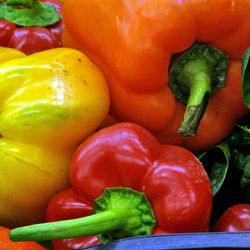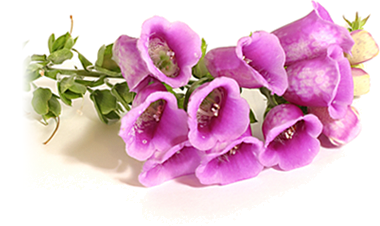Tomatoes and peppers are two crops you can never have too much of. They freeze well without the difficulty of blanching, and although the texture of tomatoes disintegrates, the flavor remains good. Both tomatoes and peppers offer brilliantly colored fruit that can be particularly attractive in the garden or in containers. Both have the same requirements – a sunny, nutrient-rich site that is well-drained. To prevent disease problems, neither should be planted in a location where tomatoes, peppers or eggplants were grown the previous year. If you’re not growing both tomatoes and peppers, you’re missing out!
Tomatoes
Tomatoes come in two different types: determinate and indeterminate. Determinate, or bush varieties, grow 1-3’ tall. When flowers form at the vine tips, the plant stops growing. This means fruit sets all at once – which makes them excellent for canning. Indeterminate types, on the other hand, have sprawling vines that grow 6-20’ long, and keep producing and growing until frost. Indeterminate vines should be pruned to ensure that they do not put too much energy into vine production. Pinch out sideshoots (“suckers”) as they develop to prevent excess growth and encourage more fruit.
Tomato plants should be set deep in the soil with the first leaf just above ground level. Leggy plants can even be planted horizontally as roots will develop from the planted stem.
Blossom-end rot can be a common problem with tomatoes. It is a leathery scar that develops on the bottom of the fruit. This is caused from a deficiency of calcium and/or irregular watering. To ensure a supply of calcium, work gypsum into the soil before planting and maintain regular watering. Feed tomatoes once a month with Garden-tone or use Miracle-Gro weekly. Apply mulch around all vegetable plants to help keep the soil moist and cool.
Another disease, early blight, makes dark, depressed areas on the leaves just as first fruit appears. Late blight appears as black, irregular, water-soaked blotches on leaves and dark-colored spots on fruits. Both diseases usually occur during cool, rainy weather. Destroy plants to keep from infecting other plants and select resistant varieties to minimize future outbreaks.
Spread by aphids, tobacco mosaic virus will appear as yellow, mottled foliage with fruit possibly being stunted. Severely affected plants should be destroyed. Aphids should be controlled to prevent infection.
Peppers
Ranging in selections from crispy sweet to fiery hot and from big and blocky to long and skinny, peppers should be cut from the plant rather than pulled off. Most sweet peppers become even sweeter when they mature as they turn from green to bright red, yellow, orange or even brown or purple. As hot peppers mature and turn red, they get hotter.
Peppers are also susceptible to blossom end rot and tobacco mosaic virus the same as tomatoes. The same measures should be taken to prevent infection.
Although we’ve touched on the most common problems with tomatoes and peppers – if you’re not sure, bring in a sample to let one of our experts correctly diagnose the problem and help you find a solution.
Types of Tomatoes & Peppers
Tomatoes
- Beefsteak – Large slicer
- Better Boy (VFN) – Medium
- Big Beef – Large slicer
- Big Girl (VF) – Medium
- Celebrity (VFNTA) – Medium
- Champion (VFNT) – Large
- Early Girl (VF)- Medium, early
- Husky Gold (VF) – Medium yellow
- Husky Red (VF) – Medium
- Lemon Boy (VFN) – Yellow
- Patio – Self-supporting, medium
- Roma (VF) – Medium
- Sunray – Yellow
- Supersonic – Medium to large
- Supersteak – Large slicer
- Sweet 100 – Cherry
Notations after the tomato variety designate their resistance to the following diseases: V-Verticillium, F-Fusarium, N-Nematodes, T-Tobacco Mosaic, A-Alternaria
Peppers
- Biscayne Italian Fryer – Sweet
- California Wonder – Sweet
- Cherry Hot – Hot
- Cubanelle – Sweet
- Golden Bell – Sweet
- Habanaro – Hot
- Hungarian Wax – Hot
- Italian Gourmet Fryer – Sweet
- Ivory Bell – Sweet
- Jalapeno – Hot
- Jupiter Green – Sweet
- Lady Bell – Sweet
- Lilac Bell – Sweet
- Long Hot Cayenne – Hot
- Mandarin (Orange Bell) – Sweet
- Sweet Banana – Sweet
In The Kitchen
There are hundreds of delicious recipes to try with either tomatoes, peppers or both at once, whether they are fresh or canned. Try this favorite tomato recipe, and use your strong crops of both of these fruits to experiment with different flavors and tastes all year long!
Scalloped Fresh Tomatoes
- 1 medium onion, chopped
- 2 Tbsp butter or margarine
- 4 medium, ripe tomatoes, sliced
- 1 cup grated sharp cheese
- 1 cup fine, soft bread crumbs
- 1 cup dairy sour cream
- 2 eggs, well-beaten
- ½ tsp salt
Cook onions in butter until tender. Place half the tomatoes in a 10 x 6 x 11 ½” baking dish. Top with half each onions, cheese and crumbs; repeat. Mix remaining ingredients. Pour over top. Bake at 350 degrees for 35-40 minutes. Serves 4-5.







